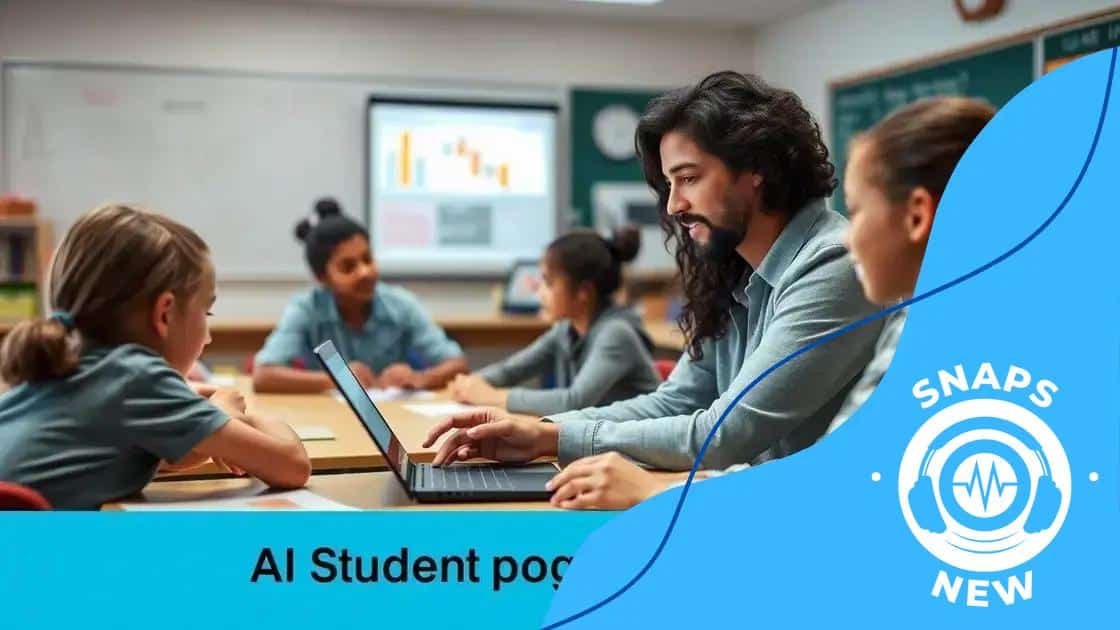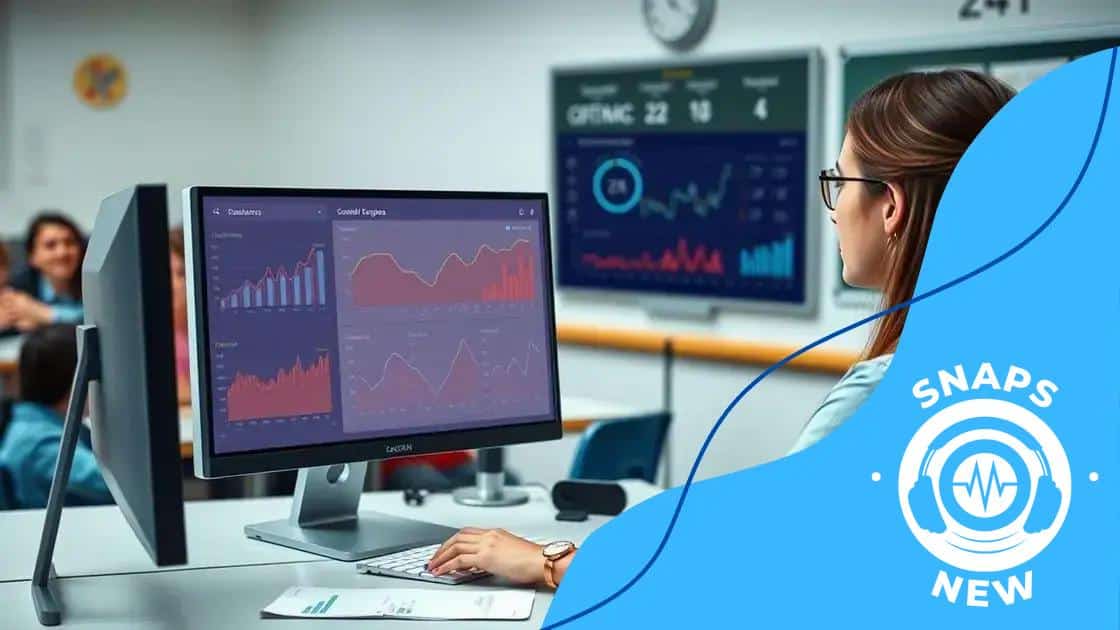AI tracking student progress: a game changer for education

AI tracking student progress enhances personalized learning by analyzing data to tailor educational experiences, identify learning gaps, and provide real-time feedback to both students and educators.
AI tracking student progress is reshaping how educators approach personalized learning. Imagine being able to identify a student’s strengths and weaknesses almost in real-time! This technology not only supports teachers but also engages students in ways we never thought possible.
Understanding AI in education
Understanding AI in education is crucial as technology continues to transform how students learn. From personalized learning paths to real-time feedback, AI plays an important role in enhancing educational experiences.
By integrating AI into classrooms, teachers can better address individual student needs. This is especially helpful in identifying which areas require more focus or support.
What is AI in education?
Artificial Intelligence involves using algorithms and data to mimic human intelligence. In education, this can mean various applications, such as:
- Learning analytics that track student performance
- Automated essay grading
- Chatbots offering 24/7 help
- Personalized tutoring experiences
As we move forward, understanding these applications can lead to better teaching methods. For example, AI can uncover patterns in learning behaviors, enabling educators to tailor their approaches.
How AI enhances classroom experiences
AI technologies help create immersive learning environments. Through virtual and augmented reality, students can engage with subjects like never before. This can make complex concepts more accessible and fun to learn.
In addition, AI-based tools can facilitate collaborations among students. These tools help track progress and encourage teamwork in projects, fostering a community atmosphere in the classroom.
With ongoing advancements, we can expect AI to continually evolve, impacting teaching methods positively. More personalized support means students can thrive in ways we never imagined before.
How AI tracks student performance
AI tracking student performance is revolutionizing education by providing valuable insights into how students learn. This technology uses algorithms and data analysis to assess various performance indicators.
For instance, AI can analyze test scores, assignment submissions, and even classroom participation to create a complete picture of a student’s progress.
Key Metrics for Tracking
To effectively measure performance, AI focuses on several key metrics, including:
- Grades and assessments over time
- Engagement levels in lessons
- Time spent on assignments
- Attendance and participation rates
By examining these areas, educators can make informed decisions about the support a student needs. This can lead to tailored learning experiences that promote growth.
Real-Time Feedback and Adjustments
One of the greatest advantages of AI is its capacity for real-time feedback. It allows teachers to receive instant updates on student progress, enabling them to adapt their teaching methods quickly.
Imagine a scenario where AI alerts a teacher that a student is struggling with a certain topic. The teacher can immediately offer additional resources or reach out for support, ultimately improving that student’s understanding.
Furthermore, this technology can help identify trends across a classroom, allowing for curriculum adjustments that benefit all students. With ongoing monitoring, teachers can ensure that no student falls behind.
Benefits of using AI for monitoring progress

The benefits of using AI for monitoring progress can greatly enhance the learning experience for students and educators alike. By leveraging technology, schools can create a more efficient and personalized learning environment.
One significant advantage is the ability to provide personalized feedback. AI systems analyze student data and generate tailored recommendations, allowing teachers to address specific learning gaps effectively.
Enhanced Learning Opportunities
Furthermore, AI helps identify individual strengths and weaknesses. This insight enables students to focus on areas that need improvement while reinforcing their strengths.
- Customized learning paths based on performance
- Timely interventions that help struggling students
- Detailed reports that track growth over time
- Increased student engagement through targeted resources
As a result, students are more motivated, and teachers can improve their instructional strategies. When teachers have access to critical data, they can adapt their teaching methods and create lessons that resonate with their students.
Improved Efficiency for Educators
Another benefit of AI in monitoring progress is efficiency. AI systems can handle large amounts of data quickly, freeing up teachers to focus on teaching rather than administrative tasks.
Moreover, AI tools can help reduce the time spent on grading and assessments. By automating these processes, teachers can dedicate more time to interacting with students. This interaction is vital for fostering a supportive learning environment.
The impact of AI technology in education is profound. With ongoing advancements, we can anticipate even more innovative solutions that will benefit both students and educators.
Challenges in AI student tracking
While AI student tracking offers many benefits, it also comes with several challenges that educators need to address. Understanding these hurdles is essential to effectively implement AI solutions in the classroom.
One major challenge is the data privacy concern. Collecting and analyzing student data requires strict compliance with privacy regulations. Schools must ensure that student information is protected and used only for educational purposes.
Technical Difficulties
Another issue is the potential for technical difficulties. AI systems can sometimes malfunction or produce inaccurate results, leading to misleading insights. These situations can create confusion and affect the trust of educators in the technology.
- Need for continuous updates and maintenance
- Dependencies on reliable internet connections
- Requirements for trained staff to operate the systems
Moreover, not all educational institutions have the budget to invest in sophisticated AI technology. This financial constraint can limit access to essential tools that could enhance learning experiences.
Resistance to Change
Resistance to change is another significant barrier. Some educators may be hesitant to adopt AI tracking tools due to fear of job loss or discomfort with new technology. This attitude can slow down the implementation process and hinder the benefits AI can offer.
Finally, the effectiveness of AI tracking relies heavily on the quality of the data input. Inaccurate or biased data can lead to poor outcomes, affecting students’ learning paths negatively.
Future trends in AI for education
The future trends in AI for education promise to reshape how students learn and educators teach. As technology evolves, we can expect exciting advancements that enhance learning experiences.
One key trend is the increasing use of predictive analytics. These tools analyze data to forecast student outcomes. With insights from analytics, teachers can proactively address issues before they escalate.
Personalized Learning Experiences
An important feature of future AI applications will be further personalization. AI will tailor educational content to match individual learning styles. Students will receive resources and tasks that fit their unique needs, enhancing engagement and understanding.
- Adaptive learning systems that adjust in real-time
- Customized recommendations for learning materials
- Gamified learning environments to boost motivation
Additionally, the integration of virtual reality (VR) and augmented reality (AR) with AI will create immersive educational experiences. Imagine students exploring historical sites or conducting science experiments without leaving the classroom!
Collaboration and Connectivity
Future trends will also emphasize collaboration. AI tools will connect students from around the world, allowing them to work together on projects and share ideas. Global classrooms will promote cultural exchange and diverse perspectives.
Moreover, teachers will benefit from enhanced support when it comes to curriculum planning. AI systems will analyze classroom performance and help educators design lessons that foster student growth.
Overall, the intersection of AI and education presents opportunities that were once thought impossible. As we embrace these trends, we can look forward to transforming the educational landscape.
In conclusion, the integration of AI in education presents numerous opportunities for enhancing the learning experience. From personalized learning paths to improved monitoring of progress, AI offers tools that can transform classrooms. However, challenges such as data privacy and resistance to change need to be addressed. By embracing advancements in AI, educators can ensure that every student receives the support they need to thrive. As we move forward, it is crucial to remain open to new technologies that can enrich education for all.
FAQ – Frequently Asked Questions about AI in Education
How does AI personalize learning for students?
AI analyzes individual student data to tailor educational content, adapting it to their unique learning preferences and needs.
What are the main advantages of AI for monitoring student progress?
AI provides real-time feedback, identifies learning gaps, and helps teachers create customized learning experiences for their students.
What challenges exist when implementing AI in education?
Challenges include data privacy concerns, technical difficulties, and resistance from educators who may be hesitant to adopt new technology.
How will AI innovations shape the future of education?
Future AI trends will enhance personalized learning, improve global collaboration among students, and streamline administrative tasks for teachers.





